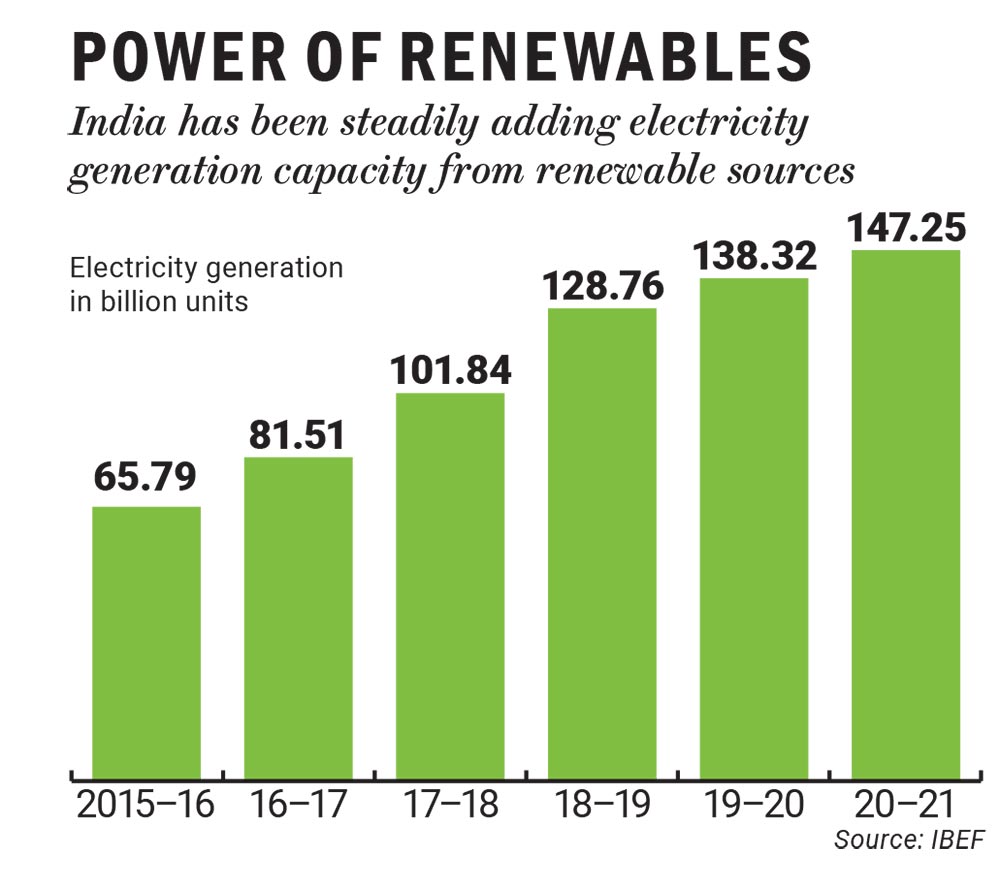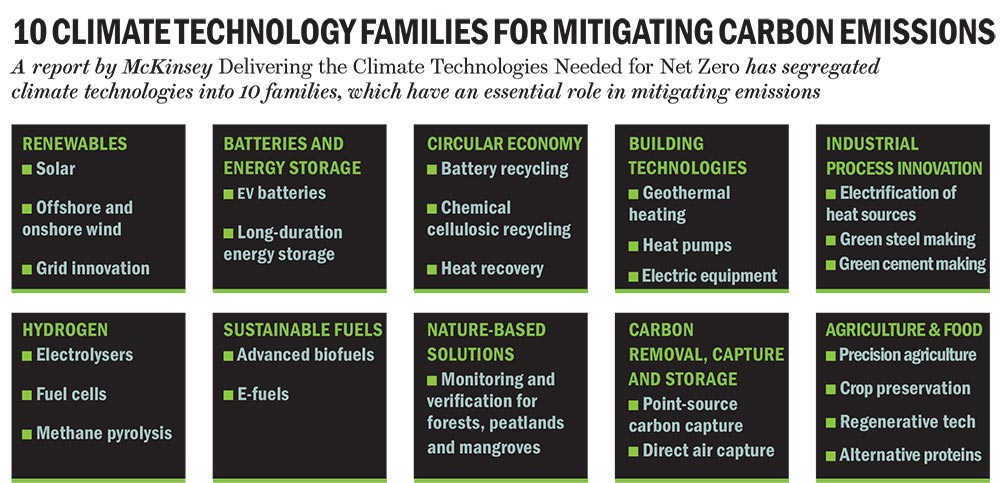India wants to reach from under 160 GW of non-fossil energy capacity at present to 500 GW in the next eight years, something it has committed to the world as part of its responsibility to reduce greenhouse gases emission. It wants to reduce the projected carbon emissions by one billion tonnes, which will cut down the economy’s carbon intensity by 45% on a baseline of 2005. It will also help the country achieve its net-zero emissions target for 2070.
After setting such ambitious decarbonisation targets, India’s focus is now understandably shifting from intent to action with climate technology as the vehicle. This journey, however, will come with its own set of costs and benefits and seek policy directions.
Cost and Benefit of Transition
A report published by the Council on Energy, Environment and Water, a Delhi-based policy research institution, notes that India will need a cumulative investment of $10.1 trillion to achieve net-zero emissions by 2070. While the renewable energy segment will need $8.4 trillion of this amount, $1.5 trillion will be required for producing green hydrogen to decarbonise the industrial sector.
The investments, though, will need a plan different from what global examples in this area suggest. Sanchit Saran Agarwal, associate fellow at the Integrated Assessments and Modelling Division, The Energy and Research Institute (TERI), feels that India’s transition challenge is different from most other countries. “In India, a substantial portion of the potential future emitting infrastructure is yet to be built or deployed. The country needs to avoid expanding the economy through legacy systems and approaches. New energy technologies and efficient practices will need to be advanced in all sectors of the economy,” he says.
Different studies peg the investments needed for India’s green journey at different levels. A recent Standard Chartered study calculates funds needed for meeting the 2070 target at $17.77 trillion, out of which it envisages a funding gap of $12.4 trillion. Depending upon how India finds these funds, it could add substantially to the size of the domestic economy. The study says that if the funding gap is filled externally by developed markets, it could increase India’s household spending by $7.9 trillion, while self-financing could reduce it by $5.8 trillion.
Greening the economy is not just a social commitment. It has economic benefits too. “India’s decarbonization journey represents upwards of a $15 trillion economic opportunity by 2070, potentially creating as many as 50 million net new jobs. With concerted action, the first $1 trillion of this opportunity could potentially materialise within this decade,” according to Mission 2070: A Green New Deal for a Net Zero India, a white paper brought out by the World Economic Forum in collaboration with Kearney, a US consultancy, and the Delhi-based Observer Research Foundation.
India on Course for a Green Future
The business case for climate investment in the country is strengthened by the proven potential of technologies in checking global warming. “The evidence is clear. We can halve emissions by 2030,” notes a report recently released by the Intergovernmental Panel on Climate Change (IPCC) Working Group III, titled Climate Change 2022: Mitigation of Climate Change.
Available options across sectors offer the substantial potential to reduce emissions by 2030, which are led by solar and wind energy segments. Current prices of solar and wind energy and batteries make them the cheapest options. Experts have calculated an 85% drop in their prices since 2010.

In fact, a low-cost climate mitigation option of less than $100 per tonnes of carbon dioxide equivalent (tCO2-eq) can halve global emissions by 2030 on a baseline of 2019, including half of that potential coming at a cheaper $20 per tCO2-eq, points out the IPCC report.
India seems to be in a better space to hit the 2030 targets than other parts of the world. “India can achieve its 2030 commitment, and, in fact, overachieve and even raise its ambitions,” says Joyashree Roy, Bangabandhu chair professor, Asian Institute of Technology, and coordinating lead author of the IPCC report, quoting from India-specific studies published in international peer-reviewed journals. “From the 2019 level, India can meet five times more demand for power by 2050 even with 100% renewable energy sources, like solar and wind, supplemented by long-distance transmission grid planning and storage and flexible demand,” she says. But, she adds, India needs planning for the power sector infrastructure and facilities and long-term vision, interstate power trade regimes and pricing from now onwards.
Agarwal agrees. He says, “India can achieve 30% of power generation from variable renewables and 45% of zero-carbon generation (including hydropower and nuclear) by 2030 at no extra cost to the system. This is only as long as policies and other measures are put in place to increase system flexibility.”
Banking on Innovation
An earlier modelling report by TERI and Shell, India: Transforming to a Net-Zero Emissions Energy System, lays down a three-pronged approach for pursuing a net-zero pathway. This comprises an acceleration of deployment of clean technologies, promotion of energy-efficient and low-carbon choices and removal of carbon emissions.
The acceleration of clean technologies includes scale-up of renewables, production and use of hydrogen in industry and transport and promotion of bioenergy, including the usage of biofuels in industry and transport. The promotion of energy-efficient and lower-carbon choices is about improving processes, technologies and end uses to cut energy intensity and supporting carbon trading. For removing carbon emissions, nature-based solutions and/or carbon capture and storage are the obvious choices.

While India is doing well in solar and wind energy generation, it needs to catch up on other technologies related to climate change. Keeping abreast of the latest developments is also imperative to reap most benefits. Emerging Sustainable Technologies, a research report by energy transition company Engie Research, gives an insight into how climate tech advances. For example, the solar industry in advanced countries is investing in integrated photovoltaics (PVs) by developing and commercialising new applications, like vehicle integrated PVs, agri PVs, infrastructure integrated PVs and building integrated PVs.
Jan Mertens, chief science officer at Engie Research and professor at Ghent University, Belgium, says: “Integrated photovoltaics are kicking in as of today! Floating on-shore PVs are gaining traction and are as good as mature.” Talking about India, he adds, “Agri PV [tech] is still emerging and [emerging] really fast. It has enormous potential, particularly for India, since it can result in a win-win situation if properly done and designed. It can lead to a better crop yield, since [PV panels] can protect plants against too much sun and increase electricity production because of the potential cooling due to the plants below.”

Greening Beyond Technology
While India seems to be exploring available technology options, this alone is not likely to achieve climate action targets. Chairman of Shell Companies in India, Nitin Prasad, an energy industry veteran, says, “An energy sector transition to net-zero CO2 emissions requires a radical technological transformation. The industry needs to collaborate with policymakers to recognise the potential and draft smart policies that drive technology development and enable cost-effective scale-up.” He adds, “These policies could incentivise, fund and build the infrastructure needed to deploy these technologies broadly. They should also promote research partnerships to accelerate innovations in this space, creating a more efficient and affordable energy transition.”
The government’s role is fundamental in laying down enabling policies and regulations. The Ministry of Environment, Forest and Climate Change is leading India’s low-carbon development journey along with the Ministry of New and Renewable energy and the Ministry of Heavy Industries. They need to work more in sync.
Corporates, as doers, need to set decarbonisation targets and track and reduce their carbon footprint. Sriram Gutta, deputy head, India and South Asia, World Economic Forum, says, “It cannot be stressed enough that business leadership will be critical to secure India’s net-zero ambitions and build a nature-positive and equitable world. Businesses will have to abandon traditional ways of doing business and adopt sustainable and equitable business models to adequately address climate change and environmental degradation.”
Since climate change is everybody’s business, there is a need for all stakeholders to rally around the cause of the next green revolution. Investors can be the catalysts for the net-zero transition by insisting on transparency and action and preferring investments in corporate companies that integrate climate action in strategy and operations. While citizens need to adopt sustainable lifestyles, civil society’s role is cut out like that of a watchdog.











